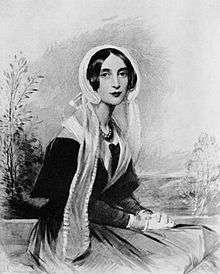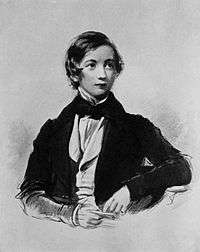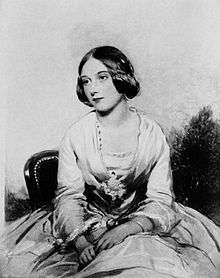Sara Coleridge
Sara Coleridge (23 December 1802 – 3 May 1852) was an English author and translator. She was the third child, out of four, and only daughter of Samuel Taylor Coleridge and his wife Sara Fricker.
Sara Coleridge | |
|---|---|
 | |
| Born | 23 December 1802 Keswick, Cumberland, England |
| Died | 3 May 1852 (aged 49) London, England |
| Occupation | Translator |
| Nationality | English |
| Spouse | Henry Nelson Coleridge |
| Children | Herbert Coleridge, Edith Coleridge, Berkeley Coleridge, Florence Coleridge, Bertha Fanny Coleridge |
| Relatives | Samuel Taylor Coleridge (father) Hartley Coleridge (brother) Derwent Coleridge (brother) |
Early life
Coleridge was born at Greta Hall, Keswick.[1] Here, after 1803, the Coleridges, Robert Southey and his wife (Mrs. Coleridge's sister), and Mrs. Lovell (another sister), widow of Robert Lovell, the Quaker poet, all lived together; but Coleridge was often away from home; and Uncle Southey was a paterfamilias. The Wordsworths at Grasmere were their neighbours.[2]

Wordsworth, in his poem, "The Triad", has left us a description, or poetical glorification, as Sara Coleridge calls it, of the three girls: his own daughter Dora, Edith Southey and Sara Coleridge, the last of the three, though eldest born.[3] Greta Hall was Sara Coleridge's home until her marriage; and the little Lake colony seems to have been her only school. Guided by Southey, and with his ample library at her command, she read by herself the chief Greek and Latin classics, and before she was twenty-five had learnt in addition French, German, Italian and Spanish.[2][4]
Career

In 1822, Sara Coleridge published Account of the Abipones, a translation in three large volumes of Martin Dobrizhoffer,[5] undertaken in connection with Southey's Tale of Paraguay, which had been suggested to him by Dobrizhoffer's volumes; and Southey alludes to his niece, the translator (canto, iii, stanza 16), where he speaks of the pleasure the old missionary would have felt if
he could in Merlin's glass have seen
By whom his tomes to speak our tongue were taught.[2]
In less grandiloquent terms, Charles Lamb, writing about the Tale of Paraguay to Southey in 1825, says, "How she Dobrizhoffered it all out, puzzles my slender Latinity to conjecture." In 1825, her second work appeared, a translation from the medieval French of the Loyal Serviteur, The Right Joyous and Pleasant History of the Feats, Jests, and Prowesses of the Chevalier Bayard, the Good Knight without Fear and without Reproach: By the Loyal Servant.[2]
In September 1829, at Crosthwaite Parish Church, Keswick, after an engagement of seven years duration, Sara Coleridge was married to her cousin, Henry Nelson Coleridge (1798–1843), younger son of Captain James Coleridge.[6] He was then a chancery barrister in London.[2]
The first eight years of her married life were spent in a little cottage in Hampstead. There four of her children were born, of whom two survived. In 1834, Mrs. Coleridge published her Pretty Lessons in Verse for Good Children; with some Lessons in Latin in Easy Rhyme. These were originally written for the instruction of her own children, and became very popular.[2]
In 1837, the Coleridges moved to Chester Place, Regent's Park; and in the same year appeared Phantasmion, a Fairy Tale, Sara Coleridge's longest original work, described by critic Mike Ashley as "the first fairytale novel written in English".[7]
Historian of literature Dennis Butts describes Phantasmion as a "remarkable pioneering fantasy" and "an extraordinary monument to her talent".[8] The songs in Phantasmion were much admired at the time by Leigh Hunt and other critics. Some of them, such as "Sylvan Stag" and "One Face Alone", are extremely graceful and musical, and the whole fairy tale is noticeable for the beauty of the story and the richness of its language. Some historians of the fantasy genre believe Phantasmion may have influenced the work of George MacDonald.[8]
Later life
In 1843, Henry Coleridge died, leaving to his widow the unfinished task of editing her father's works. To these she added some compositions of her own, among which are the essay "On Rationalism, with a special application to the Doctrine of Baptismal Regeneration", appended to Coleridge's Aids to Reflection; the preface to Essays on his Own Times, by S. T. Coleridge; and the introduction to Biographia Literaria.[2][9]
In 1850, Coleridge discovered a lump in her breast. Her physician decided not to operate, prescribing cod liver oil and opium. Knowing there was no cure, she waited for the disease to take its course.[10] "I live in constant fear", Coleridge wrote, "like the Ancient Mariner with the Albatross hung about his neck, I have a weight always upon me."[11]
Shortly before she died she amused herself by writing a little autobiography for her daughter. This, which reaches only to her ninth year, was completed by her daughter, and published in 1873, together with some of her letters, under the title Memoirs and Letters of Sara Coleridge. The letters show a cultured and highly speculative mind. They contain many apt criticisms of known people and books, and are specially interesting for their allusions to Wordsworth and the Lake Poets. Sara Coleridge died of breast cancer in London on 3 May 1852.[2]
Family
Coleridge suffered a number of miscarriages and only two of her children, Herbert and Edith, survived to adulthood. Two of Coleridge's children died in infancy.
Her son, Herbert Coleridge (1830–1861), won a double first class in classics and mathematics at Oxford in 1852. He was secretary to a committee appointed by the Philological Society to consider the project of a standard English dictionary, a scheme of which the New English Dictionary, published by the Clarendon Press, was the ultimate outcome. His personal researches into the subject were contained in his Glossarial Index to the Printed English Literature of the Thirteenth Century (1859).[2]
Her daughter, Edith Coleridge, edited a biography of Sara, The Memoir and Letters of Sara Coleridge (1873), which helped to preserve her mother's legacy.[12]
References
- Jeffrey W. Barbeau (18 June 2014). Sara Coleridge: Her Life and Thought. Palgrave Macmillan. p. 1. ISBN 978-1-137-43085-4.
- Chisholm 1911.
- Garnett 1887.
- Barbeau, 10.
- Barbeau, 13.
- Barbeau, 27.
- Ashley, Mike. "Coleridge, Sara" in The Encyclopedia of Fantasy edited by John Clute and John Grant. London, Orbit, 1999. ISBN 1-85723-893-1.
- Dennis Butts, "The Beginnings of Victorianism", in Children's Literature: An Illustrated History edited by Peter Hunt. Oxford University Press, 1995. ISBN 0192123203
- Barbeau, 116.
- Bradford Keyes Mudge; Sara Coleridge (1989). Sara Coleridge, a Victorian Daughter: Her Life and Essays. Yale University Press. ISBN 9780300162080. OCLC 804049148. Retrieved 29 June 2013.
- Griggs, Earl Leslie (1940). Coleridge Fille: A Biography of Sara Coleridge. London: Oxford University Press.
- Schofield, Robin (12 February 2018). The Vocation of Sara Coleridge: Authorship and Religion. Springer. p. 6. ISBN 9783319703718.
- Attribution


Further reading
- Kathleen Jones (2 March 2000). A Passionate Sisterhood: Women of the Wordsworth Circle. Palgrave Macmillan. ISBN 978-0-312-22731-9. Retrieved 29 June 2013.
- Dennis Low (2007). The Literary Protégées of the Lake Poets. Ashgate Publishing, Ltd. ISBN 978-0-7546-8790-0. Retrieved 29 June 2013.
- Sara Coleridge (2007). Peter Swaab (ed.). Collected Poems. Carcanet. ISBN 978-1-85754-895-2. Retrieved 29 June 2013.
External links
| Library resources about Sara Coleridge |
| By Sara Coleridge |
|---|
- Works of Sara Coleridge at Internet Archive (Archive.org)
- Memoir and Letters of Sara Coleridge, edited by Edith Coleridge at Internet Archive
- A Poet's Children: Hartley and Sara Coleridge, by Eleanor Towle at Internet Archive
- The Genealogy of Coleridge Family and Coleridge links at the Wayback Machine (archived 29 October 2009) – "Sorry. This URL has been excluded from the Wayback Machine." (2019-12-05)
- "Worlds Within Worlds: The First Heroic Fantasy (Part IV)" by Matthew David Surridge at Black Gate: Adventures in Fantasy Literature – argues that Phantasmion is the first fantasy novel set entirely in a Secondary World
- Sara Coleridge Coleridge at Library of Congress Authorities, with 21 catalogue records